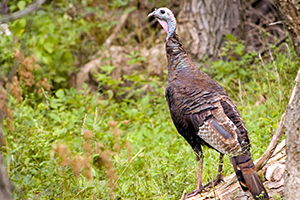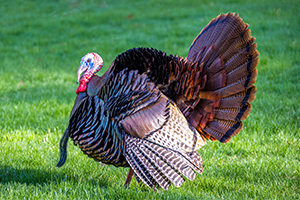Know Hens from Gobblers
Telling the Difference Between Male and Female Turkeys
It is against the law to kill a hen turkey during the spring season (it is legal to take a bearded hen turkey, but hunters are encouraged to pass on bearded hens in order to maximize turkey population growth). Hunters are, therefore, legally obligated to know the difference between hens and gobblers. This skill can be acquired through reading, field observation, watching videos, and attending a turkey hunting seminar.
- The turkey "beard" is not a reliable indicator of sex. The beard may be broken or obscured from view. Many males, including jakes (one-year-old males) have short beards that are difficult to see. Up to 10 percent of hens will have thin 6- to 8-inch beards. These hens represent a valuable segment of the turkey nesting population and hunters are urged to pass on them whenever possible.
- Physical characteristics can be used to differentiate hens and gobblers. Gobblers have pronounced red, white and blue head coloration during the spring season. The white skull cap on the gobbler is distinct, as is the presence of leg spurs and prominent red wattles on the neck. The body coloration of a gobbler is distinctly dark, almost black. In contrast, hens have a smaller, bluish-gray head, lack spurs and prominent wattles, and are brownish in appearance. Finally, gobblers strut, fan their tails and gobble; hens do not.
- The sex of a turkey "in hand" is readily determined. Look at a small chest or breast feather. Gobbler feathers are black-tipped, while hen feathers are buff-tipped.
| Feature | HEN | GOBBLER |
|---|---|---|
| Photo |  |
 |
| Head | blue-gray color | red, blue and white colors |
| Body | light, rusty-brown | black |
| Beard | usually no beard | long bristle-like beard |
| Spurs | no spurs | usually 1/2-inch or longer spurs |
| Calls | yelp, cluck, cut | gobble, drum |
| Strut | no strut | strut with tail fan and wing droop |
| Size | 1/2 to 2/3 size of gobbler | larger than hen |



